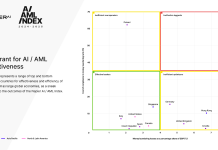When it comes to navigating the challenges of economic crime, establishing a threat matrix can be a key way to steady the ship.
This point was broadly argued by RegTech firm Acuminor in a whitepaper that looked in greater detail at helping to create a standardized taxonomy.
According to Acuminor, it’s highly likely that many companies been directly involved in creating an economic crime ‘threat matrix’ or ‘typology library’ for their organisations.
Alternatively, they may have engaged in designing a threat matrix that enables communication with external parties. If they have, the firm said it would be familiar with the associated complexities. On the other hand, if they haven’t, they can probably envisage the daunting task of describing each potential economic crime threat their organisation might encounter, in a language that is not only consistent and actionable but also understood by all relevant stakeholders.
A standardised taxonomy for economic crime can be the panacea to these challenges, claims Acuminor Despite being one of the oldest and most entrenched threat landscapes, with fraud and bribery persisting throughout human history, the categorisation of such threats by affected parties still lags behind other industries.
Creating a threat matrix that effectively documents these crimes can be a herculean task. Take human trafficking as an example. The questions surrounding its documentation are multifarious: should you approach the typology from the perpetrator’s or the victim’s perspective? Should you start from the source country or the destination? And how should the impact on different sectors of your organisation be portrayed in the matrix? The challenges become exponential as exposure to more crimes occurs.
Moreover, the ever-evolving landscape of threats, with new mechanisms for generating and concealing illicit funds being continually devised, only adds to the challenge. Regulators, tasked with setting standards and rules, often view the threat landscape from an exterior perspective. This can result in reactive regulatory reforms that might lack direction due to insufficient ‘on the ground’ understanding of evolving threat typologies. The introduction of novel technologies such as digital assets, coupled with cultural shifts and new work approaches, adds to the regulators’ workload in combating these threats.
The interpretation of Suspicious Activity Reports (SARs) by law enforcement can be challenging, and the reported risks often lack the necessary context to trace the crimes to their origin. The lack of a common language curtails the utility of SARs and significantly slows the response process.
Public-Private Partnerships (PPPs) play a crucial role in transitioning towards an intelligent financial crime model. However, information sharing is often done in a disorganised manner and lacks strategic-level abstraction to prevent recurrent industry crimes.
In an earlier report, we underscored the merits of similar taxonomies in the cybersecurity industry. A corresponding model for economic crime could outline different threats and techniques, articulate their potential impacts, provide a historical record of economic crime evolution, and facilitate more efficient and effective information sharing within PPPs.
The link to the full whitepaper can be accessed here.
Acuminor recently partnered with Algbra to roll out its risk assessment professional platform across the latter’s operations.
Keep up with all the latest FinTech news here
Copyright © 2023 FinTech Global











